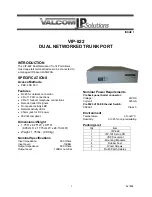
Inductive Probe 8398
4
2. OPERATING
PRINCIPLE
2.1 Conductivity
reminder
Electrolytic conductivity refers to the ability of a liquid to conduct an electrical current (conductivity is
the opposite of resistivity). In metals, the electrical current flows by electron displacement, in liquids it
flows by ion transport. The conductivity of a solution is dependent both upon the solution’s ionic
concentration and temperature.
To obtain a solution's actual conductivity (in S.cm
-1
), it is necessary to multiply the
measured conductance 1/R (in S) by a coefficient dependent solely upon the
geometry of the probe and termed "cell or K constant", expressed in cm
-1
.
R
K
C
(S.cm
-1
)
In order to allow the comparison between measurements made at different
temperatures, this measurement needs to be brought back to a
reference
temperature
(generally 25
°C). This temperature dependency can be easily
expressed in the form of relative variation in degrees Celsius. It is referred to as the
temperature coefficient (
D
).
C
Tref
= C
T
[1 +
D
(T - T
ref
)]
-1
C
Tref
:
Conductivity compensated to the reference temperature
C
T
:
Conductivity measured at T
T
ref
:
Reference temperature (generally 25 °C)
D
:
Temperature coefficient of the solution (% / °C)
Examples:
Product Soda
(NaOH)
5 %
Nitric acid (HNO
3
)
10 %
D
:
2.01 1.45
REMARK:
1 S = 1000 mS (R = 1
:
)
1 mS = 1000 μS (R = 1 k
:
)








































